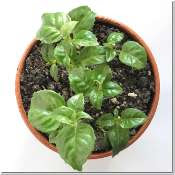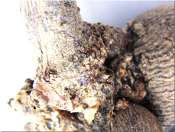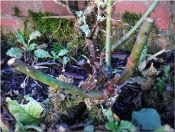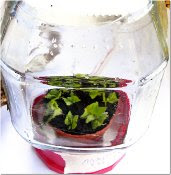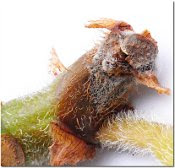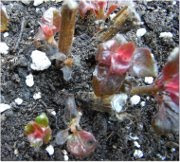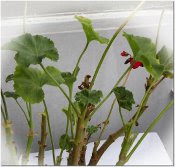
A typical plant or animal cell is comprised of a filling of cytoplasm containing various organelles, including a nucleus, all enclosed in a plasma membrane. Both plant and animal cells are very similar, except plant cells have a cellulose cell wall around the plasma membrane, plastids (e.g. chloroplasts) and a conspicuous vacuole.
Each organelle has its own special function. Do not burden yourself with these at this stage. This is 'purely for the record':
Cell WallThe primary cell wall consists mostly of layers of cellulose microfibrils, surrounding the plasma membrane. As the cell develops, further layers of microfibrils are laid down in different directions.
Cellulose has a tensile strength (ability to resist extension) approaching that of steel (cotton consists mostly of cellulose). So once turgid (filled with liquid), the cell is well-supported. The microfibrils are given further strength and support by running through and linking with a matrix of hemicelluloses and pectins.
Further strengthening is achieved by laying down the woody compound lignin.
Between the cells is an adhesive layer of the sticky gel-like magnesium and calcium salts (pectates) of pectins; it is called the middle lamella and holds neighbouring cells together.
Plasma MembraneThis is rather like a balloon which surrounds the cell contents. However, it can selectively allow certain materials into and out of the cell. Some materials are always allowed through; others regulated; others rejected. Thus the cell can, against the laws of diffusion, if necessary maintain a constitution different from its surroundings.
Nucleus
This is the control centre of the cell activity, especially the regulation of genetic material DNA. DNA is contained on the chromosomes and is replicated (according to information encoded in the genes) along with the chromosomes, during normal cell division (mitosis), so that each new cell is identical to its sibling; it is also replicated at gamete formation in sexual reproduction (meiosis). The nucleus is surrounded by a double membrane called the nuclear envelope.
Nucleolus
This is a darkened area within the nucleus and is the site of ribosome production.
Chloroplasts
These contain the enzymes necessary for photosynthesis, plus the green pigment chlorophyll which has the function of absorbing light energy, and gives plants their typical green colour.
RibosomesThe site of protein synthesis, according to instructions given to RNA from DNA in the nucleus. RNA carries these instructions out of the nucleus and into the ribosomes.
Mitochondria
The site of energy production, the powerhouse of the cell, through a process called 'respiration'. Respiration is the reverse of photosynthesis and releases energy from the carbohydrate glucose.
Endoplasmic ReticulumA network of parallel membranes which extends throughout the cell. If associated with ribosomes (rough endoplasmic reticulum), its function is to manufacture proteins; if not (smooth endoplasmic reticulum), it is associated with lipid (fat) synthesis.
Golgi ApparatusThis collects, processes and distributes materials to be used inside and outside the cell, e.g. enzymes, and cellulose for cell walls.
VacuoleA major function of this organ is cell 'skeletal' support. As it takes in water, it extends and makes the cell 'turgid' by forcing the contents against the wall. It also acts as temporary storage for various materials.
Microtubules
A support cell, forming the 'cytoskeleton'. It forms the spindle, a structure used in cell division.
Microfilaments
Also part of the 'cytoskeleton'. They control 'cytoplasmic streaming', the movement of cytoplasm within the cell, allowing the movement of chloroplasts to take advantage of changing light directions during the day.
Plasmodesmata
Pores through which plasma membranes of adjacent cells can connect through tubes (desmotubules) of endoplasmic reticulum. Allows regulated transport between cells.
 Encouraged by healthy new fuchsia growth on cuttings taken last October, and - as you shall see shortly - by similar growth in the coffee jar propagator, I could not resist taking some new cuttings, just to see if they will take (yes, I know it's foolish - we usually get a break like this in the winter weather (though usually later, about mid-February)). I had trained myself to resist the said temptation. But this time it somehow feels different. I don't know why. Perhaps it's with being so close to the Solstice.
Encouraged by healthy new fuchsia growth on cuttings taken last October, and - as you shall see shortly - by similar growth in the coffee jar propagator, I could not resist taking some new cuttings, just to see if they will take (yes, I know it's foolish - we usually get a break like this in the winter weather (though usually later, about mid-February)). I had trained myself to resist the said temptation. But this time it somehow feels different. I don't know why. Perhaps it's with being so close to the Solstice. Encouraged by healthy new fuchsia growth on cuttings taken last October, and - as you shall see shortly - by similar growth in the coffee jar propagator, I could not resist taking some new cuttings, just to see if they will take (yes, I know it's foolish - we usually get a break like this in the winter weather (though usually later, about mid-February)). I had trained myself to resist the said temptation. But this time it somehow feels different. I don't know why. Perhaps it's with being so close to the Solstice.
Encouraged by healthy new fuchsia growth on cuttings taken last October, and - as you shall see shortly - by similar growth in the coffee jar propagator, I could not resist taking some new cuttings, just to see if they will take (yes, I know it's foolish - we usually get a break like this in the winter weather (though usually later, about mid-February)). I had trained myself to resist the said temptation. But this time it somehow feels different. I don't know why. Perhaps it's with being so close to the Solstice.







